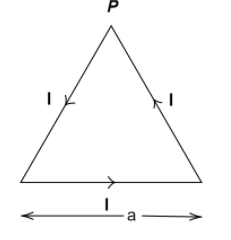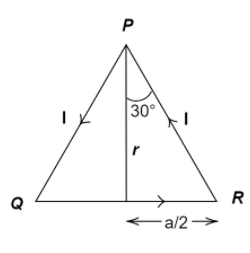Question
Question: An equilateral triangle of side \(a\) carries a current \(I\). What is the magnitude and direction o...
An equilateral triangle of side a carries a current I. What is the magnitude and direction of the magnetic field at the point P?

Solution
First, we have to know about the magnetic field and how it can be generated from electricity. We can determine the magnetic field's magnitude thus produced if we know about the correlation between the electric field and the magnetic field. After that, we can find out the direction of the generated magnetic field with the right-hand rule.
Formula used:
B=2πrμ0I
Complete step by step solution:
The vector field that describes the magnetic influence on moving electric charges or electric current or any other magnetic material is known as the magnetic field. A current-carrying wire can produce a magnetic field in its surroundings. The right-hand rule can determine the direction of the magnetic field. The correlation of the current and the produced magnetic field can be given as-
B=2πrμ0I
where,
B is the magnitude of the magnetic field
I is the current flowing through the conductor
μ0 is the magnetic permittivity of vacuum
r is the distance from the conductor to the point of the magnetic field
However, here, we will think more deeply and use symmetry to solve our problem.
So the sides PQ and PR do not contribute to the generation of the magnetic field at P.

Here,
⇒r=a2−(2a)2=a2−4a2
Upon solving further we get,
⇒r=43a2
⇒r=23a
Therefore,
⇒B=4πμ0.rI[sinα1+sinα2]
We put α1=α2=30∘ , and we get-
⇒B=4πμ0.(23a)I[sin(30∘)+sin(30∘)]
We put sin(30∘)=21-
⇒B=23πaμ0I[21+21]
⇒B=23πaμ0I
Hence, the magnitude of the generated magnetic field is 23πaμ0I , and with the right-hand rule, we can determine that the magnetic field's direction is upward, i.e., pointing outward of the page.
Note: In this problem, we have used the Biot-Savart Law to determine the magnetic field. We will always use the Biot-Savart Law to solve problems where we can use symmetry to find out the magnetic field generated due to the action of a current-carrying conductor.
